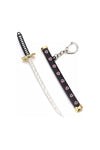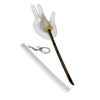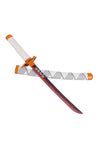
What weapons did the samurai use? : Evolution, Symbolism and Mastery
Origins and Evolution of the Samurai Class
The history of Japan is deeply rooted in the evolution of the samurai warrior class. Initially, the term "samurai" referred to those who closely served the nobility. However, during the tumultuous Sengoku period, samurais gained a predominant status, becoming the ruling military class of Japan. Even during the Edo period, a relatively peaceful era, samurais maintained their status while taking on bureaucratic and administrative roles.
The evolution of the samurai's role has been remarkable. Starting as simple foot soldiers in service to regional lords, they became guardians of a strict code of conduct infused with values such as loyalty, self-discipline, and honor. This distinguished class formed the backbone of Japanese society during the Edo period, and its influence is still felt in the modern era.
Roles and Social Responsibilities of the Samurai
Samurais are often associated with the image of warriors wielding the katana, but their role extended far beyond the battlefield, especially during the Edo period marked by relative stability. They took on administrative and governmental responsibilities, where their disciplined approach was highly valued.
The samurai class wasn't only comprised of fighters. They were also scholars, poets, and philosophers who made significant contributions to Japanese culture and arts. Their commitment to "Bushido," the way of the warrior, emphasized virtues such as loyalty, mastery of martial arts, and respect. This unique blend of martial and cultural skills helped shape Japan's history.
Main Weapons of the Samurai
The Katana: Iconic Symbol
The katana, a legendary Japanese sword, is often considered the iconic weapon of the samurai. Its curved blade, measuring two to three feet, was designed for delivering lethal strikes, ideal for the swift and decisive combat of samurais. Each katana was meticulously crafted by master artisans and represented more than just a weapon; it was a symbol of the samurai's status and honor.
The katana was typically paired with a much shorter sword, such as a wakizashi, forming a set known as "daisho." This combination of long and short swords became synonymous with the samurai class. The wakizashi's blade, though shorter than the katana, played a crucial role in both combat and rituals, including the famous ritual suicide known as seppuku, practiced in certain situations to preserve the samurai's honor.
The Yumi:
The Samurai's Longbow Despite most samurais having less upper body strength compared to Western archers, the yumi, an asymmetrical Japanese longbow, was another crucial weapon in the samurai's arsenal. With its unique shape and size, the yumi could shoot arrows with considerable force, capable even of penetrating armor. Archery was considered a vital skill, evolving into a martial art, Kyudo. This discipline demanded discipline, concentration, and precision, cultivating the samurai's character.
The Yari: Versatile Spear
The yari, a polearm with a long blade, was another primary weapon used by samurais. Its design allowed samurais to keep enemies at a distance while delivering powerful strikes. Moreover, its length provided a strategic advantage in battles, especially against cavalry. During the Sengoku period, the yari became a weapon of choice on the battlefield due to its versatility and effectiveness.
Lance combat techniques were integral to samurai training. Some samurais even preferred the yari over the katana due to its range and versatility. Although the yari is less commonly associated with samurais than the katana or yumi, it reflects the population's emphasis on the individual prowess of samurais rather than their role in large-scale warfare.
Other Notable Weapons and Armor In addition to the katana, yumi, and yari, samurais used a variety of other weapons. The tanto, a type of short sword or dagger, was commonly used as a secondary weapon. The naginata, a polearm with a curved blade at its end, was preferred by female samurais for defending their homes. Samurai armors, called Yoroi, were designed to provide protection while allowing freedom of movement. They were crafted with a balance between aesthetics and functionality, adorned with traditional patterns and often customized for each warrior.
When to Use Different Samurai Weapons?
Determining Factors in Weapon Choice The choice of a samurai's weapon depended on various factors, including the nature of the combat, personal preferences, and the era. During the Heian period, when samurais were primarily mounted archers, the bow was their primary weapon. However, as warfare evolved into closer combat, the sword and spear gained prominence. During the peaceful Edo period, where samurais were less involved in active combat, their weapon of choice was often the wakizashi or tanto, ideal for self-defense and law enforcement in their domain.
The choice of the weapon was not arbitrary. Samurais had to master their chosen weapon, understand its strengths and weaknesses, and know how to use it best in various scenarios. This mastery was linked to the samurai's identity and social status, making the choice of the weapon highly meaningful.
Strategic Use of Different Weapons in Combat
Knowing when to use a particular weapon was crucial in samurai training. The katana, for example, was often favored for close combat, with its sharp single-edged blade being perfect for quick and decisive strikes. However, on more open battlefields, a samurai might opt for the yari or naginata, with their greater reach providing an advantage. Although the yumi lost its utility as a combat weapon, it remained a key element in samurai martial arts, symbolizing the warrior's discipline and concentration.
The decision to use a particular weapon was not limited to the battlefield. In times of peace, samurais typically wore the daisho, consisting of the katana and wakizashi, almost constantly, as a symbol of their status. However, they could also use these weapons for self-defense or maintaining order. Conversely, in times of war, the samurai would carry a full array of weapons, ready to face any combat situation.
Understanding the Art of Samurai Weapons
Appreciating the Craftsmanship of Samurai Swords The beauty of samurai weapons, especially the katana, lay not only in their effectiveness as war tools but also in their artistic quality. Crafting a katana was a sacred process, with master artisans spending weeks or even months forging, shaping, and sharpening the blade. The resulting katana was a functional artistic masterpiece, its blade sharp enough to cut silk while remaining flexible enough to withstand combat.
However, the art of crafting was not limited to the blade. The hilt of the short sword was often wrapped in braided silk for optimal grip, and the handguard, or tsuba, could be intricately decorated, illustrating classical themes from Japanese history or mythology. Every aspect of the sword, from the curve of the blade to the handle design, reflected the samurai's status and personal preferences.
The Symbolism of Armament
Beyond their function as war tools, samurai weapons were deeply symbolic. The katana, for example, was considered the soul of the samurai or the "soul of the warrior." This idea extended far beyond the samurais themselves to become a symbol of Japan's martial history and ethics. Other weapons also carried their own symbolism. The yumi symbolized the spiritual discipline of samurais, while the yari represented their adaptability on the battlefield.
Furthermore, samurai weapons were personal. Each one was carefully crafted to fit its owner, with decorations and design choices often holding deep significance. Some samurais commissioned specific patterns or symbols for their weapons, reflecting their personal beliefs, family lineage, or martial exploits. This customization made each weapon a unique object, an extension of the samurai himself.
Understanding the Rituals Surrounding Samurai Weapons
Samurai weapons were not just combat tools and status symbols; they also played a significant role in various rituals. For example, the katana and wakizashi were at the center of the act of seppuku, a form of ritual suicide practiced to restore family honor after disgrace. Additionally, when entering a superior's house, a samurai would leave his long sword at the door as a sign of respect, retaining only his short sword.
Even the process of creating a samurai weapon was steeped in rituals. Blacksmiths purified themselves before starting their work, and the forging process itself was accompanied by Shinto rituals. This spiritual dimension of crafting samurai weapons underscores the deep respect and reverence that samurais had for their weapons, adding another layer of depth to the understanding of their art.
Reflection on the Samurai's Armory
The world of samurais, rich in history and cultural nuances, extends well beyond the famous katana. Each piece of the samurai's arsenal, from the katana to the shorter wakizashi, to the yumi and yari, testifies to the art and discipline of these elite warriors. Each of these weapons, including the traditional daisho consisting of the katana and wakizashi, embodies not only their social status but also their personality. Details of craftsmanship, such as the tsuba, providing both protection and artistic value, offer insight into the mastery and art that are integral to samurai culture. Understanding the depth and complexity of samurai armament allows us to more deeply appreciate the extent of their legacy.































